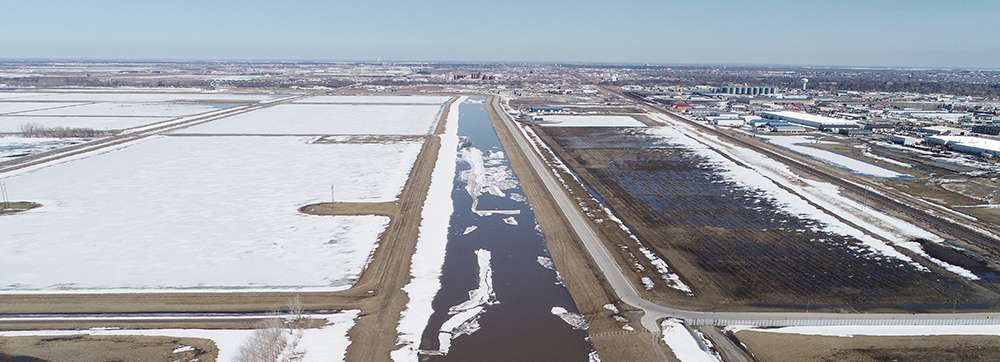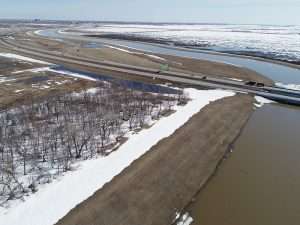
Inside the Flood Fight, Part 3: Many Variables Make Flexibility Key
Experience and technology help Moore’s water resources engineers predict what is likely to happen during a flood event. Yet, every flood event is different. There are many reasons for this, and this final installment of “Inside the Flood Fight” (see part 1 and part 2) explores some of the variables that make flexibility a key attribute for water resources engineers.
Client Needs Change
 Moore Engineering serves many types of clients during a flood fight. Our most prominent are water resource districts and cities, but we also collaborate with counties, airport authorities, landowners, state government officials and others. While the information all these stakeholders need is often related, each is presented with different challenges during a flood fight.
Moore Engineering serves many types of clients during a flood fight. Our most prominent are water resource districts and cities, but we also collaborate with counties, airport authorities, landowners, state government officials and others. While the information all these stakeholders need is often related, each is presented with different challenges during a flood fight.
For example, Moore was the city engineer for West Fargo from 1963 to 2018. During those years, we experienced many different flood fights together. When the Sheyenne River diversion was completed in 1992, it changed West Fargo’s flood fights forever.
Before the diversion, Moore’s engineers and West Fargo city employees worked furiously to protect properties from the overflowing river. After the diversion, the emphasis was on monitoring the diversion to ensure it was functioning as planned, protecting the cities of West Fargo and Horace.
Change is the Only Constant
For water resources engineers, change is the only constant. As nature, landowners, developers and communities alter the landscape, the flow of water during a flood event is inevitably impacted, potentially changing conditions from one flood event to the next.
“We have a lot of experience tracking surface water in this region, which is very useful” says Mike Opat, Moore water resources engineer. “But we also need to be aware of how things change between flood events. That’s why it’s important to continually monitor how the landscape is changing through communicating with landowners and clients, tracking known landscape alterations and visual inspections by land and air.”
Moore’s use of drone technology is increasing as we monitor land conditions. Our drones fly areas to look for ice jams, tree limb snagging and other impediments to free water flow. But we also rely on traditional personal communication.
Employees continuously communicate with public officials and individual landowners to learn how the landscape is different from the last flood event and how that might affect water flow and flood behavior. Throughout the region, our water resources engineers seek information to make better judgments and decisions.
Ice Jams Create Uncertainty
 Ice jams on rivers are almost always a problem when flooding seems like it might be imminent. River ice often breaks up in chunks and bunches up at a river’s choke points – maybe at a bridge or culvert, or just a narrowing of the channel.
Ice jams on rivers are almost always a problem when flooding seems like it might be imminent. River ice often breaks up in chunks and bunches up at a river’s choke points – maybe at a bridge or culvert, or just a narrowing of the channel.
With the north-flowing Red River, ice jams are compounded because the air temperature generally gets colder as the river proceeds north. Water from melted snow in the south has nowhere to go if the ice has not melted yet in the north. This creates unique flooding patterns as jammed up water is constrained in places engineers would not normally expect it.
Overland vs. River Flooding
Another big variable is overland flooding versus river flooding. Of course, the amount of water is important when assessing impact. But the same amount of water in the region can create many variations of a flood event depending on where and how fast snow melts and where ice jams impact the river and frozen up culverts impact drainage ditches, among other things.
Opat says one set of conditions can create a great deal of overland flooding, threatening farmsteads, cropland and roads. Another set of conditions with the same volume of water can put more pressure on the river channels themselves, possibly pushing more water through the cities where the river flows. Whatever happens requires water resources engineers and other flood fighters to be flexible in their reactions and to understand how a great many different scenarios will affect the region.
“Having good data for decision making is crucial,” says Opat. “That comes from experience, personal communication, monitoring data from the water level gauges and being aware of the latest models from the National Weather Service. The commitment of so many of our employees and partners make us as successful as we can be. But sometimes Mother Nature still throws us a curveball.”
Patience and flexibility – these are key attributes for a water resources engineer during a flood fight.